Look, I get it. You’re tired of walking into your living room and feeling like you’re navigating an obstacle course of mismatched furniture, random knick-knacks, and that one pillow your aunt gave you that you absolutely hate but feel guilty about tossing. I’ve been there, staring at my cluttered space wondering why every home magazine makes minimalism look so effortless while my room looks like a furniture store exploded.
Here’s the thing about minimalist living rooms—they’re not about depriving yourself or living like a monk. They’re about creating a space that actually lets you breathe. A room where you can actually find the remote (revolutionary, I know). After transforming my own chaotic living space into something that doesn’t give me anxiety every time I walk through the door, I’m here to share 15 minimalist living room ideas that pack serious modern charm without making your home feel cold or empty.
Ready to create a space that’s equal parts calm and stylish? Let’s get into it.
Neutral Toned Serenity Living Room

Ever notice how some rooms just instantly make your shoulders drop and your breathing slow down? That’s the magic of a neutral-toned minimalist living room. I’m talking about those gorgeous combinations of whites, beiges, creams, and soft grays that make everything feel like a spa day.
The beauty of neutral tones lies in their versatility. You’re not committing to one specific vibe—you’re creating a canvas that works with pretty much anything you want to add later. When I first switched to a neutral palette, I was worried everything would look boring. Spoiler alert: it didn’t.
Here’s how to nail this look:
- Start with a foundation: Choose a soft white or warm beige for your walls
- Layer different textures: Mix linen sofas with wool throws and cotton cushions
- Add depth with varying shades: Don’t go monotone—use 3-5 different neutral shades
- Keep furniture simple: Clean-lined sofas and chairs in complementary neutrals
- Incorporate natural materials: Wood, stone, and rattan keep things from feeling sterile
The trick is in the layering. You want your neutral room to feel rich and inviting, not flat and lifeless. Think of it like making the perfect latte—you need different shades working together to create something visually interesting.
Japandi Minimalist Space

Okay, so Japandi is basically what happens when Japanese minimalism and Scandinavian coziness have a baby, and honestly? That baby is gorgeous. This style combines the clean simplicity of Japanese design with the warm functionality of Scandinavian aesthetics.
I fell hard for Japandi after visiting a friend’s apartment that perfectly nailed this vibe. The space felt simultaneously zen and inviting—like you could meditate or binge-watch Netflix with equal comfort. IMO, this is one of the most livable minimalist styles out there.
Key elements of Japandi design:
- Low-profile furniture: Think platform sofas and low coffee tables
- Natural wood tones: Especially light woods like oak, ash, or birch
- Wabi-sabi philosophy: Embrace imperfection and handcrafted items
- Muted color palette: Soft grays, warm whites, and earthy tones
- Functional beauty: Every piece serves a purpose while looking stunning
- Minimal ornamentation: Keep decorative items purposeful and few
The secret sauce? Balance. You’re mixing the warmth of Scandinavian hygge with the disciplined simplicity of Japanese design. Neither style overwhelms the other—they dance together beautifully.
Warm Minimalist Living Room with Wooden Accents

Can we talk about how minimalism got this weird reputation for being cold? Because a warm minimalist space proves that theory completely wrong. Adding wooden accents to your minimalist living room is like adding butter to toast—it just makes everything better.
Wood brings life, texture, and warmth without adding visual clutter. I transformed my stark white living room by introducing a chunky wooden coffee table and some floating shelves, and suddenly the space went from “operating room” to “actual home where humans live.”
Ways to incorporate wooden accents:
- Statement coffee table: Go for solid wood with visible grain patterns
- Exposed wooden beams: If you’ve got them, flaunt them
- Wooden shelving: Floating shelves in natural wood create storage without bulk
- Wood-framed furniture: Sofas and chairs with visible wooden frames add warmth
- Accent wall: Consider wooden wall paneling in a light finish
- Natural wood flooring: Light oak or maple keeps things bright but warm
The goal is finding the right wood tone for your space. Lighter woods like maple and ash keep things airy, while walnut and oak add richness. You don’t need to go full cabin-in-the-woods—even a few strategic wooden pieces make a massive difference.
Black and White Contrast Minimalist Design

Nothing says “I have my life together” quite like a sharp black and white minimalist living room. This high-contrast look is bold, timeless, and surprisingly easy to pull off once you understand the formula.
I’ll be honest—when I first attempted this style, I went way too heavy on the black and ended up with something that looked more “gothic teenager” than “sophisticated adult.” The key is getting the ratio right. You want mostly white with black as your accent punch.
Creating the perfect black and white balance:
- 70/30 rule: Aim for roughly 70% white and 30% black
- White walls and floors: Keep your base bright
- Black furniture pieces: A black sofa, coffee table, or accent chairs
- Graphic elements: Black and white photography or geometric art
- Strategic black accents: Lighting fixtures, picture frames, or textiles
- Play with patterns: Stripes, geometric prints, or abstract designs in black and white
The beauty of this palette is its timelessness. You’re not going to look back in five years and cringe at your design choices. Plus, you can easily swap in colorful accents when you want a change without disrupting the whole vibe.
Scandinavian Inspired Minimalist Living Room

Ah, Scandinavian design—the original minimalism that doesn’t make you feel like you’re living in a museum. This style perfected the art of simple, functional, and cozy long before minimalism became an Instagram trend.
What I love about Scandi style is how it prioritizes actual livability. These rooms look stunning in photos but also work for real life—you know, where you need to store stuff and actually sit comfortably. The Scandinavians figured out that minimalism should make life easier, not harder.
Essential Scandinavian elements:
- Light, bright spaces: Maximize natural light wherever possible
- White or light gray walls: Keep things bright during dark winters
- Cozy textiles: Chunky knit throws, sheepskin rugs, soft cushions
- Functional furniture: Simple designs that serve multiple purposes
- Natural materials: Wood, leather, wool, linen, and cotton
- Pops of muted color: Soft blues, dusty pinks, or sage greens
- Candles and lighting: Lots of warm, ambient lighting options
The hygge factor is crucial here. Your Scandinavian minimalist living room should feel like a warm hug, not a sterile showroom. Think less “design magazine” and more “actually want to spend time here.”
Also Read: 15 Dreamy Living Room Inspiration Ideas for Cozy Vibes
Cozy Minimalist Apartment Lounge
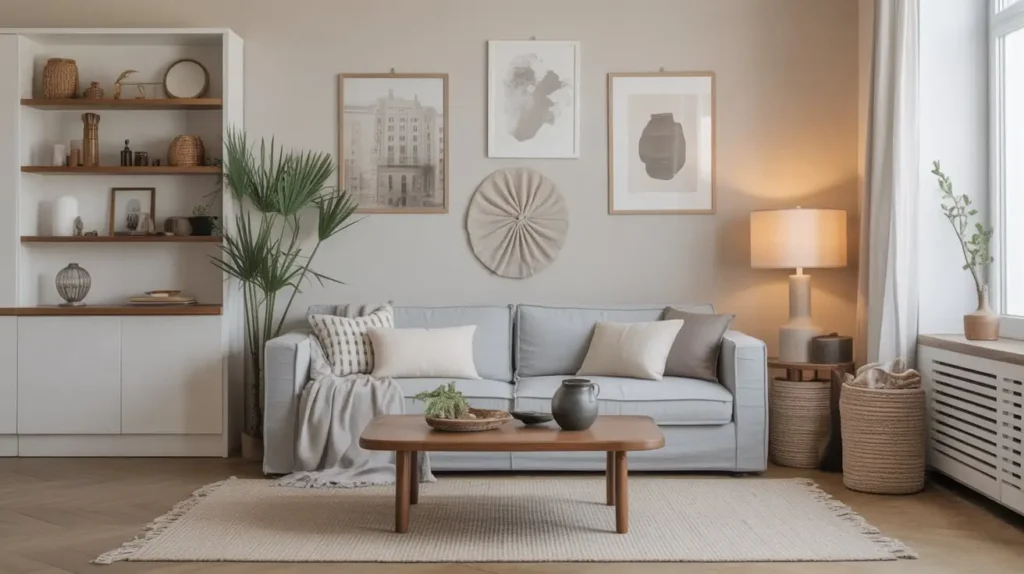
Small apartment? No problem. Creating a cozy minimalist lounge in a compact space actually works better than you’d think. Minimalism and small spaces are basically best friends—less stuff means your tiny apartment doesn’t feel like a storage unit.
I lived in a 450-square-foot apartment for three years, and going minimalist was the only thing that kept me sane. When you can’t expand your space, you have to get strategic about what stays and what goes.
Small space minimalist strategies:
- Multi-functional furniture: Ottomans with storage, sofa beds, nesting tables
- Wall-mounted everything: Shelves, TV units, even your desk if possible
- Light colors: Keep walls and large furniture light to maximize perceived space
- Mirrors: Strategically placed mirrors double your visual space
- Vertical storage: Use your wall height when you can’t spread out
- Less is genuinely more: Every item should earn its place
- Clear pathways: Maintain open flow for movement
The trick is intentionality. In a small space, every single item needs to justify its existence. That decorative bowl you never use? It’s gotta go. FYI, this ruthless approach actually becomes liberating once you get into it 🙂
Light and Airy Minimalist Space with Natural Textures
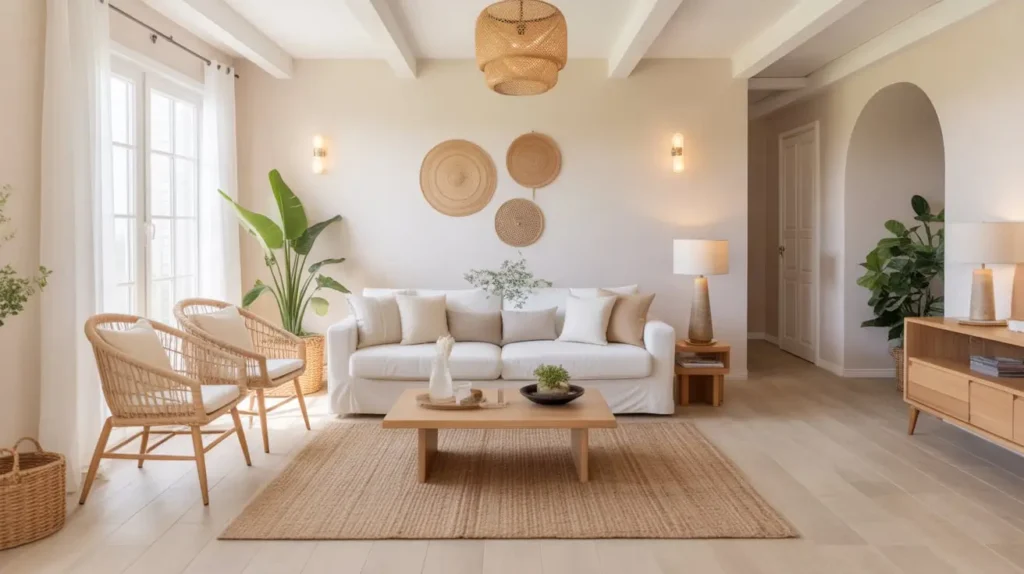
Want to know the secret to preventing your minimalist living room from feeling like a dentist’s waiting room? Natural textures. Seriously, this is the game-changer that separates “cold and uninviting” from “light and welcoming.”
Texture adds visual interest without adding clutter. When I figured this out, my whole approach changed. Instead of adding more stuff, I focused on varying the materials and textures of what I already had.
Layering natural textures effectively:
- Jute or sisal rugs: Add warmth and organic texture underfoot
- Linen curtains: Soft, natural, and perfect for filtering light
- Woven baskets: Storage that looks intentional and beautiful
- Raw wood elements: Unfinished or lightly finished wood pieces
- Stone or concrete accents: Coffee tables, planters, or decorative objects
- Natural fiber cushions: Cotton, linen, wool, and hemp
- Rattan or wicker furniture: Lightweight and texturally interesting
Think about how these textures interact with light. Natural materials catch and reflect light differently than synthetic ones, creating depth and dimension that makes a room feel alive and dynamic.
Minimalist Living Room with Statement Art
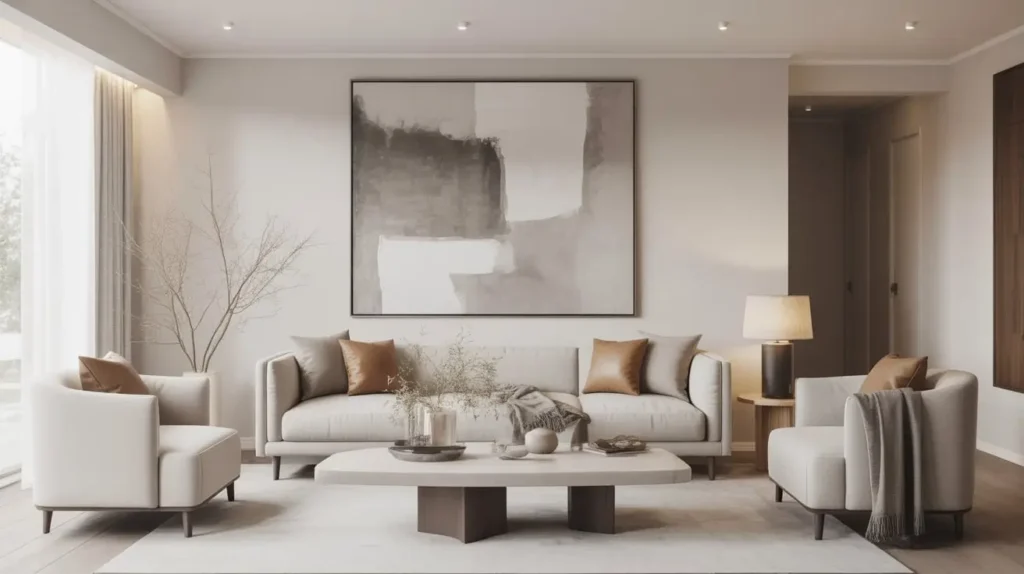
Here’s where minimalism gets fun. A single piece of statement art in an otherwise simple room creates instant drama and personality. You’re basically letting one amazing piece steal the show while everything else plays supporting actor.
I used to think minimalist spaces meant no personality, but then I hung one large abstract painting above my sofa and everything clicked. That single piece gave my entire room an identity without overwhelming the space.
Choosing and displaying statement art:
- Go big or go home: One large piece beats several small ones in minimalist spaces
- Consider scale: Your art should be roughly 2/3 the width of your sofa
- Create breathing room: Leave plenty of empty space around your statement piece
- Color coordination: Pull colors from the art into your accents
- Lighting matters: Properly light your art to give it prominence
- Abstract or photography: Both work beautifully in minimalist settings
- Frame thoughtfully: Simple frames or frameless options work best
Your statement art becomes the conversation starter in your room. It’s the one place where you can inject serious personality without cluttering your carefully curated minimalist vibe.
Earthy Tones Minimalist Aesthetic

If the stark white minimalist trend makes you feel slightly dead inside, let me introduce you to earthy tones minimalism. Think terracotta, warm browns, soft taupes, sage greens, and clay colors. This palette brings all the calm of minimalism with the warmth of nature.
I switched to an earthy palette last year and my living room went from “nice but cold” to “place I actually want to spend every evening.” The difference was honestly shocking. Turns out I’m not a cool-toned person—I’m an earthy, warm-toned person who needs colors that feel grounded.
Building an earthy minimalist palette:
- Start with warm neutrals: Taupe, beige, and cream as your base
- Add terracotta accents: Cushions, throws, or pottery
- Incorporate clay tones: Burnt orange, rust, and warm browns
- Use sage or olive green: Plants or textile accents
- Natural materials only: Wood, stone, clay, and natural fibers
- Muted over bright: Keep colors soft and dusty rather than vibrant
The connection to nature is what makes this palette so calming. These are the colors you see on a hike or at the beach—they’re hardwired into our brains as peaceful and safe.
Sleek Modern Minimalist Living Room

Ready for something with a bit more edge? A sleek modern minimalist living room leans into clean lines, glossy surfaces, and contemporary design. This is minimalism with a sophisticated, urban vibe.
This style works particularly well if you love a polished, put-together look. I use this approach in my own space because I like things that look intentional and designed, not accidental. It requires a bit more maintenance (fingerprints on glossy surfaces are real), but the payoff is worth it.
Elements of sleek modern minimalism:
- Streamlined furniture: Sharp lines, geometric shapes, no fussy details
- Glossy or matte finishes: Choose one and stick with it for cohesion
- Metal accents: Chrome, brushed nickel, or matte black metal
- Glass elements: Coffee tables, shelving, or accent pieces
- Monochromatic or limited palette: Usually black, white, gray with one accent color
- Hidden technology: Cable management is crucial for this look
- Reflective surfaces: Strategic use of mirrors and glass
The key word here is intentional. Nothing about this look happens by accident. Every piece needs to be chosen deliberately, and everything needs to be in its place. If you’re naturally organized, you’ll love this style. If you’re naturally messy… maybe work on that first.
Boho-Minimalist Fusion Style
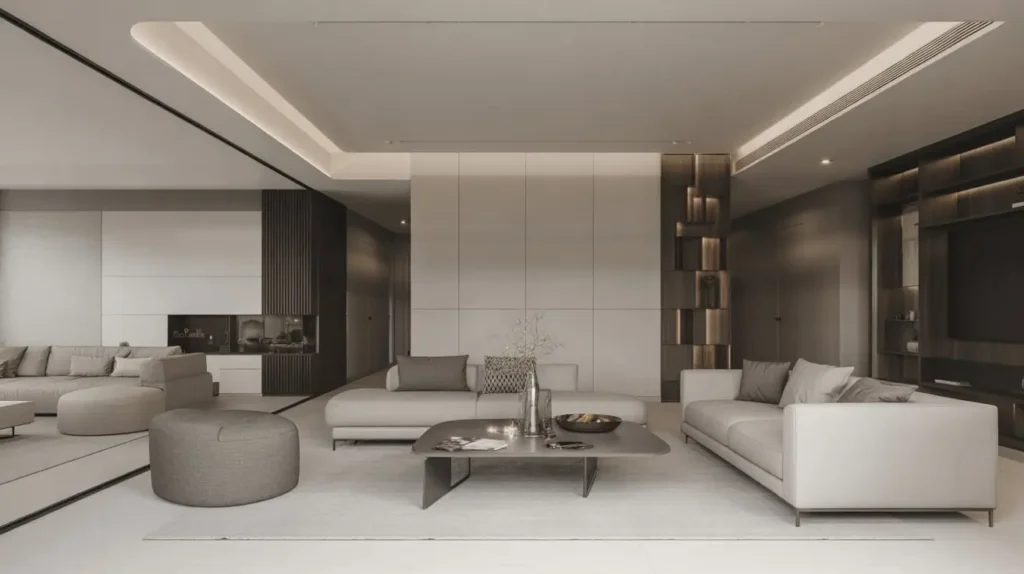
Wait, can you really combine bohemian and minimalist styles? Absolutely, and the result is fantastic. Boho-minimalist fusion takes the relaxed, eclectic vibe of boho and applies minimalist restraint. You get personality and warmth without the clutter.
This is my personal favorite style because it lets you have fun while maintaining the clean, uncluttered feeling of minimalism. You can travel, collect meaningful pieces, and display them without your living room looking like a flea market exploded.
Creating boho-minimalist balance:
- Curated collection: Only display items you genuinely love
- Natural materials dominate: Rattan, jute, wood, and plants
- Textural variety: Mix woven wall hangings with soft textiles
- Limited color palette: Stick to earthy, natural tones
- Statement plants: A few large plants instead of many small ones
- Macramé or woven pieces: Choose one or two, not ten
- Handcrafted items: Pottery, baskets, or artisan textiles
The magic happens when you edit ruthlessly. Every boho piece needs to earn its place. You’re not trying to recreate a Moroccan bazaar—you’re selecting the best pieces and giving them room to breathe.
Also Read: 15 Dreamy Apartment Living Room Inspiration Ideas for 2025 Homes
Minimalist Living Room with Floor-to-Ceiling Windows

If you’re lucky enough to have floor-to-ceiling windows, you’ve basically won the minimalist living room lottery. Massive windows flood your space with natural light and provide ever-changing natural artwork. Seriously, why would you cover that up?
I once helped a friend design her living room around enormous windows, and the biggest challenge was not screwing up what was already perfect. When you have this much natural light and view, your job is to enhance, not compete.
Maximizing floor-to-ceiling windows:
- Minimal window treatments: Sheer curtains or skip them entirely if privacy allows
- Arrange furniture to face the view: Don’t waste the focal point
- Keep colors light: Let the natural light bounce around the room
- Reduce clutter near windows: Clear sightlines to the outside
- Use the light for plants: Position plants where they’ll thrive
- Simple window frames: Keep frames clean and minimal
- Consider glare: Strategic furniture placement to avoid screen glare
Your windows are doing the heavy lifting here. They provide light, view, visual interest, and even entertainment (people-watching, anyone?). Your design job is to get out of their way and let them shine.
Minimalist Monochrome Living Room
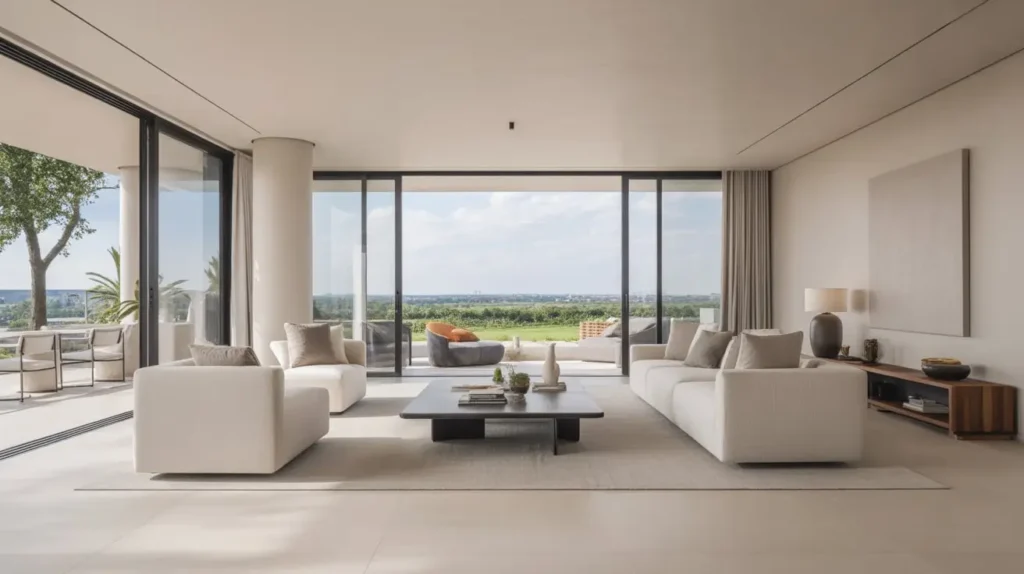
A monochrome minimalist living room takes the color question off the table entirely. You pick one color and work with its various shades, tints, and tones. The result? Sophisticated, cohesive, and surprisingly dynamic.
I experimented with an all-gray monochrome scheme once, and while it looked magazine-worthy, I found it a bit depressing long-term. Monochrome works best when you choose a color that genuinely makes you happy, not just one that photographs well.
Making monochrome work:
- Choose your color carefully: Consider how it makes you feel
- Use at least 5 different shades: Variety within your chosen color
- Vary your textures heavily: This is crucial for visual interest
- Add metallic accents: Gold, silver, or copper for dimension
- Play with patterns: Geometric or organic patterns in your chosen color
- Consider lighting effects: How does your color look at different times of day?
- One small contrast accent: A single contrasting color can add pop
The discipline of monochrome forces you to get creative with texture, pattern, and shade variation. It’s minimalism on hard mode, but when you nail it, the results are stunning.
Minimalist Space with Hidden Storage Solutions
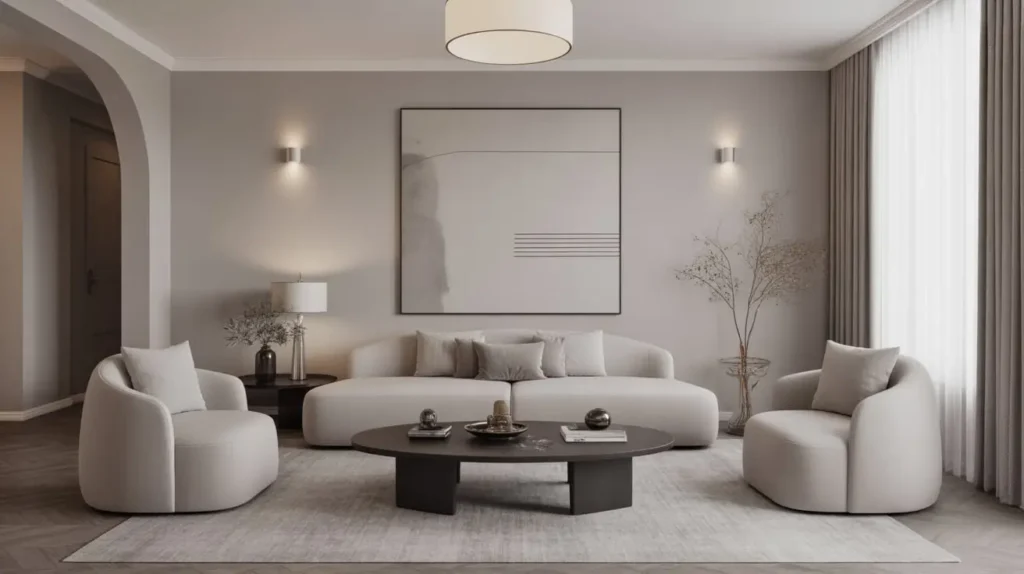
Let’s get real—minimalism isn’t about owning nothing. It’s about hiding the stuff you need so your space looks calm and organized. Hidden storage is the secret weapon of every successful minimalist living room.
I’ll tell you what changed my life: discovering furniture with hidden compartments. Suddenly I could own normal human amounts of stuff while maintaining that clean minimalist aesthetic. It felt like cheating, but in the best possible way.
Clever hidden storage ideas:
- Ottoman with storage: Doubles as seating and hides blankets, remotes, magazines
- Lift-top coffee tables: Surface area plus hidden storage underneath
- Built-in cabinetry: Custom built-ins that blend into walls
- Under-sofa storage: Low-profile bins that slide under your couch
- Wall-mounted cabinets: Floating units that don’t eat floor space
- Hollow bench seating: Window seats or bench-style seating with lift-tops
- Behind-door storage: Use the backs of doors for slim storage
The goal is strategic concealment. Everything has a home, but those homes are cleverly disguised. Your living room looks minimal, but you haven’t actually gotten rid of everything you own. Smart, right?
Minimalist Living Room with Pops of Greenery

Here’s the easiest way to elevate any minimalist space: add plants. Greenery brings life, color, and literal fresh air to your living room without adding clutter. Plants are the perfect minimalist accessory because they’re functional, beautiful, and constantly changing.
I used to kill every plant I touched (seriously, my track record was embarrassing), but I finally learned which plants actually thrive on neglect. Now my minimalist living room has strategic green pops that make everything feel more alive.
Best plants for minimalist spaces:
- Large statement plants: Fiddle leaf fig, monstera, or bird of paradise
- Snake plants: Nearly indestructible and architecturally interesting
- Pothos: Easy-care trailing plant for shelves or hanging planters
- ZZ plants: Tolerates low light and occasional watering
- Rubber plants: Bold leaves and easy maintenance
- Succulents: Minimal water, maximum style (in small doses)
Placement strategy matters. A few large, healthy plants beat a collection of small, struggling ones. Choose simple pots that complement your overall design—white, terracotta, or matte black work beautifully in minimalist settings.
Group plants in odd numbers (one, three, or five) and vary their heights for visual interest. And please, keep them alive. Dead plants are the opposite of minimalist charm
Final Thoughts
Look, transforming your living room into a minimalist space with modern charm isn’t about following rigid rules or copying someone else’s Pinterest board exactly. It’s about figuring out which approach resonates with you and actually makes your life better.
I’ve tried most of these styles in various forms, and here’s what I’ve learned: minimalism should reduce stress, not add it. If maintaining your perfectly styled living room makes you anxious about someone sitting on your sofa, you’ve missed the point. Your space should work for your life, not the other way around.
Start with one approach that speaks to you. Maybe it’s the warm wooden accents, or perhaps you’re drawn to that Japandi vibe. Implement it gradually, see how it feels, and adjust as needed. The beauty of minimalism is that you can always add elements from other styles—you just do it thoughtfully rather than impulsively.
And remember, minimalism is a journey, not a destination. Your living room will evolve as you do, and that’s exactly how it should be. The goal is creating a space that feels calm, looks modern, and actually works for how you live.





